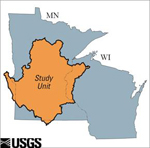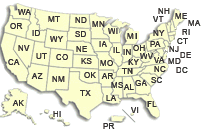
UMIS NAWQA
USGS IN YOUR STATE
USGS Water Science Centers are located in each state.

|
Water-Quality Assessment of Part of the Upper Mississippi River Basin, Minnesota and Wisconsin--Volatile Organic Compounds in Surface and Ground Water, 1978-94: U.S. Geological Survey Water-Resources Investigations Report 95-4216
By Andrews, W.J., Fallon, J.D., and Kroening, S.E.
Abstract
The U.S. Geological Survey compiled and summarized analyses of volatile organic compounds (VOC's) in surface and ground water from water-quality data bases maintained by Federal, State, and local agencies as part of
a retrospective analysis of water-quality data for the Upper Mississippi River Basin study unit of the National Water-Quality Assessment Program. The retrospective analysis focused on a study area that encompasses 19,500 square miles of the eastern portion of the study unit. Major river basins in the study area include the part of the Upper Mississippi River drainage from Lake Pepin upstream to sampling stations on the Mississippi and Minnesota Rivers where long-term water-quality data are available and the entire drainage basin of the St. Croix River. The Twin Cities metropolitan area, with a population of 2.4 million people, is located in the south-central part of the study area. Water-quality data collected in the study area from 1978 through 1994 by the U.S. Geological Survey, the Minnesota Department of Health, the Minnesota Pollution Control Agency, the Wisconsin Department of Natural Resources, the Metropolitan Council Environmental Services, and the city of Minneapolis were included in the
retrospective analysis.
In this report, assessment of the presence and distribution of VOC's in surface and ground water in the study area is restricted to two groups of VOC's: target VOC's, and triholomethane compounds (THM's). Target VOC's, the most commonly detected non-trihalomethane VOC's in surface and ground water in the study area, include 1,1-dichloroethane, 1,2-dichloroethane, 1,1,1-trichloroethane, trichloroethene, tetrachloroethene, benzene, ethylbenzene, toluene, meta+para-xylene, and ortho-xylene. Trihalomethane compounds described in this report include chloroform, bromodichloromethane, chlorodibromomethane, bromoform, and fluorodichloromethane.
Examination of water-quality data from widely distributed sampling networks of river sites and wells in the study area led to the following conclusions:
- trace amounts of chlorinated VOC's were detected sporadically in waters of the Mississippi, Minnesota, St. Croix, and Vermillion Rivers;
- benzene, ethylbenzene, toluene, and meta+para-xylene were detected sporadically in waters sampled from the chain of lakes used as the municipal supply for St. Paul, Minnesota;
- the target VOC's were detected in less than five percent of ground-water samples at relatively low concentrations, generally near detection limits which ranged from 1 to 5 micrograms per liter;
- VOC's were generally detected at similar frequencies, but at higher concentrations, in water samples from wells completed in sand and gravel aquifers than in water samples from wells completed in bedrock aquifers;
- VOC's were most commonly detected in ground water in the vicinity of identifiable emission sites of VOC's, such as landfills, dumps, or major industries;
- trichloroethene, a commonly used degreasing agent in dry cleaning, metal cleaning, and cleaning septic lines, was the most frequently detected target VOC in ground water sampled from wells completed in both sand and gravel and bedrock aquifers;
- wells producing water with detectable concentrations of the target VOC's tended to be shallower than wells producing water with no detectable concentrations of those compounds, but the differences in well depths were not statistically significant at a 95-percent confidence level; and
- chlorination of water substantially increased the frequency of detection of trihalomethane compounds.
The low frequencies of detection of the target VOC's and THM's in surface and ground water sampled from widely distributed sampling networks in the study area indicate that, although there are thousands of sites which can potentially emit these compounds to water, soil, and the atmosphere, these compounds have not had a widespread measurable effect on the quality of surface and ground water in the study area.
Copies of this report and information on all USGS products can be obtained by calling 1-888-ASK-USGS
|